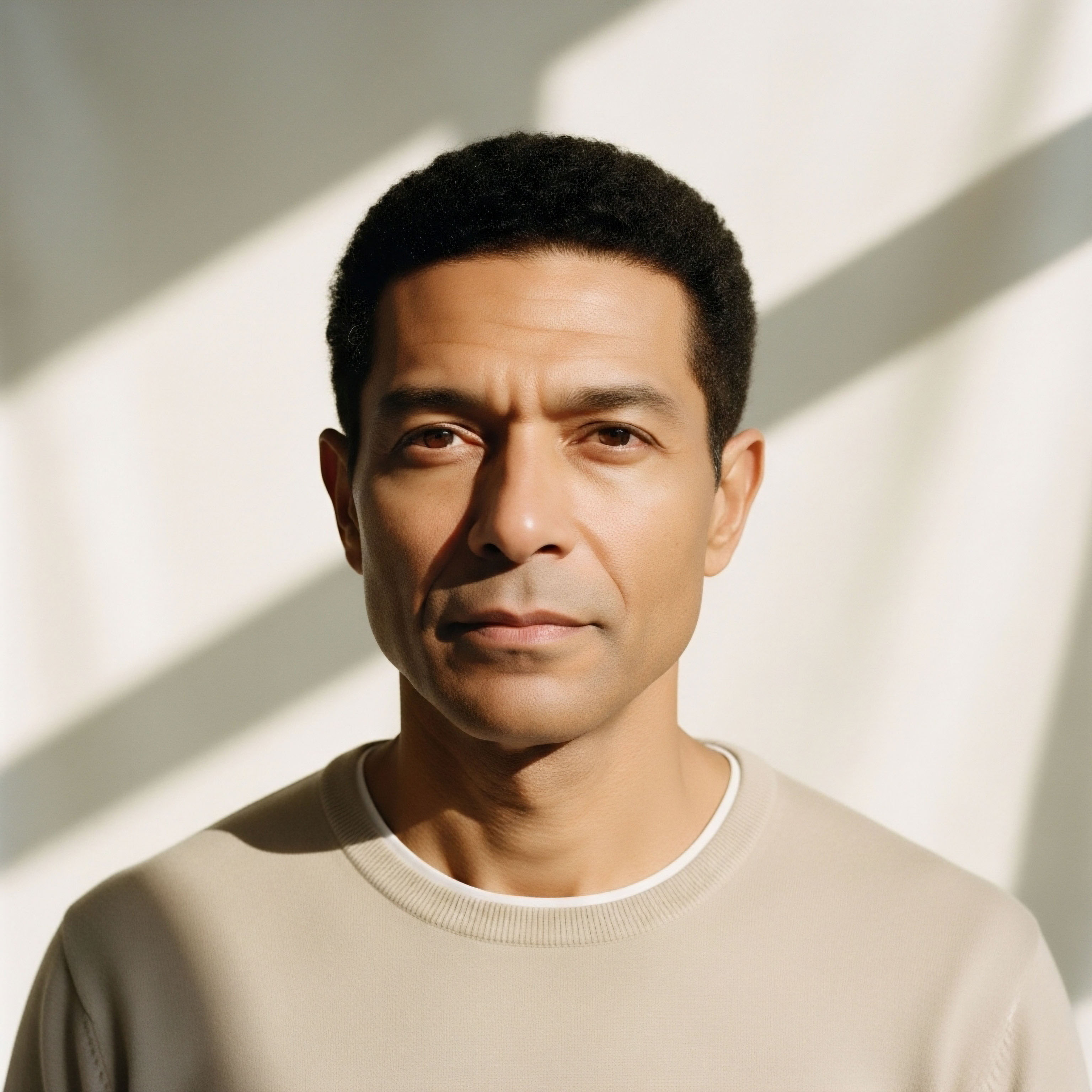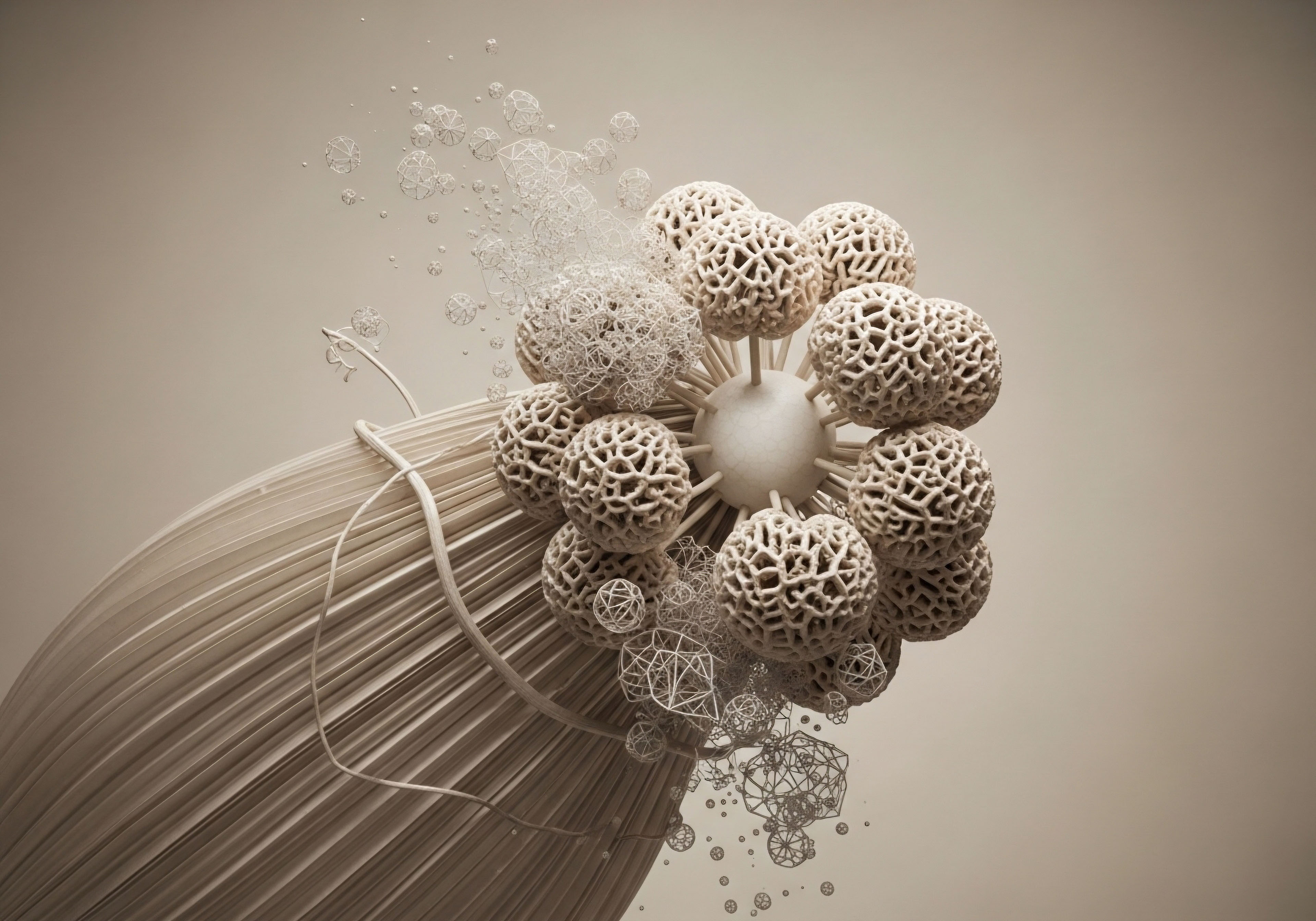

Fundamentals
You may recognize a subtle yet persistent friction in your daily life. It is the feeling of being out of sync, where your energy does not match the demands of your day, and your sleep fails to restore you. This experience is a direct reflection of a profound biological conversation occurring within your body every moment.
Your internal sense of vitality is governed by an intricate, self-regulating system of internal clocks, collectively known as the circadian rhythm. This system is the master conductor of your physiological orchestra, dictating the tempo of everything from your sleep-wake cycles to your metabolic rate.
Within this orchestra, your hormones are the principal musicians, and androgens like testosterone play a particularly powerful role. The music they produce, however, depends entirely on whether their instruments are properly tuned and ready to receive the conductor’s cues. This is where androgen receptors enter the narrative.
Androgen receptors are highly specific protein structures located within your cells. Think of them as sophisticated docking stations designed exclusively for androgens. When testosterone circulates through your bloodstream, it seeks out these receptors. Upon binding, a cascade of genetic instructions is unlocked, influencing cellular function, growth, and communication.
This process is fundamental to maintaining muscle mass, bone density, cognitive function, and metabolic health. The density and sensitivity of these receptors determine the power of the hormonal signal. A high concentration of sensitive receptors allows for a robust response even with moderate androgen levels, while fewer or less responsive receptors can mute the message, leading to symptoms of deficiency despite what lab reports might suggest are normal hormone concentrations.

The Master Clock and Its Messengers
Your body’s entire network of circadian rhythms is synchronized by a central pacemaker located in a tiny region of your hypothalamus called the suprachiasmatic nucleus, or SCN. The SCN functions like a central atomic clock, interpreting light signals from your eyes to align your internal 24-hour cycle with the external day-night cycle.
This master clock communicates its timing cues to peripheral clocks located in virtually every organ and tissue of your body, from your liver to your muscles, ensuring the entire system operates in cohesive harmony. This elegant system relies on a core set of “clock genes,” primarily CLOCK and BMAL1, which partner to initiate a cascade of genetic activity.
They activate other genes, including Period (PER) and Cryptochrome (CRY), which, over the course of the day, accumulate and eventually suppress the activity of CLOCK and BMAL1, creating a precise, self-regulating 24-hour feedback loop.
Androgen receptors act as the critical bridge, translating the broad hormonal signals of testosterone into specific, time-sensitive instructions at the cellular level.
The conversation between your hormonal system and your circadian system is constant and bidirectional. The SCN, through its connection to the rest of the brain and pituitary gland, dictates the rhythmic daily release of testosterone, which typically peaks in the early morning and declines throughout the day.
In turn, testosterone travels to the SCN and other tissues, where it binds to androgen receptors. This binding directly influences the activity of the clock genes themselves. Androgen receptors, therefore, are the molecular conduits through which your hormonal status informs and modulates your internal sense of time. Understanding this relationship is the first step in moving from a state of physiological dissonance to one of conscious, directed recalibration, where your internal rhythms and hormonal vitality are aligned for optimal function.


Intermediate
To truly appreciate how deeply androgen receptors and circadian rhythms are intertwined, we must examine the elegant feedback mechanism that connects your endocrine system to your body’s central pacemaker. This is a dynamic, responsive loop where each system continuously informs and adjusts the other.
The primary conductor of this process is the Hypothalamic-Pituitary-Gonadal (HPG) axis, the command structure for sex hormone production. The suprachiasmatic nucleus (SCN) sits atop this axis, initiating the signal. Based on the 24-hour light-dark cycle, the SCN directs the hypothalamus to release Gonadotropin-Releasing Hormone (GnRH) in a pulsatile, rhythmic manner.
This GnRH pulse signals the pituitary gland to release Luteinizing Hormone (LH), which then travels to the Leydig cells in the testes, instructing them to produce testosterone. This entire cascade is inherently circadian, which is why testosterone levels naturally follow a diurnal rhythm, peaking shortly after you wake.
This pathway, however, is a two-way street. The testosterone produced circulates back to the brain, where it directly interacts with the very clock that initiated its release. Neurons within the SCN are equipped with androgen receptors.
When testosterone binds to these receptors, it acts as a transcription factor, a molecule that can enter the cell’s nucleus and directly influence which genes are expressed. This binding modulates the expression of core clock genes, such as PER1, effectively fine-tuning the clock’s sensitivity and function.
This creates a neuroendocrine feedback loop ∞ the SCN regulates the timing of testosterone secretion, and testosterone, in turn, modulates the SCN’s function. This system is designed for stability, allowing your body to adapt its internal rhythms based on your hormonal status.

How Does Androgen Signaling Calibrate the Clock?
The influence of androgen receptors extends beyond simple feedback; it directly calibrates how the master clock responds to its primary environmental cue ∞ light. Research shows that androgens, acting through their receptors in the SCN, can alter the clock’s photosensitivity.
This means that hormonal status can determine how strongly a light signal, such as morning sunlight or evening artificial light, affects your internal rhythms. Gonadectomy, the removal of the gonads and the primary source of androgens, has been shown to alter the SCN’s response to light, an effect that is rescued by the administration of androgens like dihydrotestosterone (DHT).
This indicates that androgen receptor signaling is a key variable in the equation that governs how your body synchronizes with the external world. A healthy androgen signal helps maintain a robust, stable circadian rhythm that is less easily perturbed by minor disruptions.
Disruptions in the feedback loop between androgen receptors and circadian clocks can lead to a state of internal desynchronization, manifesting as fatigue, metabolic issues, and poor sleep.
When this finely tuned system is disrupted, the consequences are felt throughout the body. Conditions like chronic sleep deprivation, irregular schedules from shift work, or the natural decline of androgens with age can weaken this feedback loop. For instance, persistent elevations of the stress hormone cortisol, often a result of poor sleep, can interfere with testosterone production.
Simultaneously, low testosterone levels can impair the SCN’s ability to maintain a strong rhythm, making the body more susceptible to circadian disruption. This can initiate a downward spiral, where poor sleep lowers testosterone, and lowered testosterone further degrades sleep quality and circadian stability.
This state of desynchronization is now being recognized clinically as “Circadian Syndrome,” a condition characterized by metabolic dysfunction, sleep disturbances, and hormonal imbalance, underscoring the necessity of viewing hormonal and circadian health as two facets of the same whole.
The following table outlines the key components in this bidirectional communication system:
| Component | Role in the Feedback Loop | Primary Location of Action |
|---|---|---|
| Suprachiasmatic Nucleus (SCN) | Acts as the master circadian pacemaker, initiating the rhythmic signal for testosterone production. Contains androgen receptors for feedback. | Hypothalamus |
| Androgen Receptor (AR) | Binds with testosterone/DHT to directly modulate the expression of clock genes within the SCN and peripheral tissues. | SCN Neurons, Leydig Cells, Muscle, etc. |
| Testosterone | Functions as the hormonal messenger, carrying the signal from the gonads back to the central clock and peripheral clocks. | Circulates Systemically |
| CLOCK/BMAL1 Proteins | Form the core transcriptional driver of the circadian clock; their activity is influenced by AR signaling. | Nucleus of SCN and Peripheral Cells |
| PER/CRY Proteins | Form the negative arm of the clock’s feedback loop; their expression can be modulated by androgen receptor activity. | Nucleus of SCN and Peripheral Cells |


Academic
At the molecular level, the regulation of circadian rhythm by androgen receptors is a process of direct genomic influence. The central engine of the mammalian circadian clock is the heterodimer formed by the transcription factors CLOCK and BMAL1. This complex binds to specific DNA sequences known as E-boxes in the promoter regions of target genes, initiating their transcription.
This rhythmic binding drives the expression of not only the core clock components like Per and Cry but also a vast array of clock-controlled genes that govern up to 15% of the transcriptome, orchestrating daily cycles in metabolism, cell division, and detoxification. The androgen receptor, a ligand-activated transcription factor, integrates into this intricate machinery by acting as a potent modulator of this core loop.
Upon binding to an androgen such as testosterone or its more potent metabolite, dihydrotestosterone (DHT), the androgen receptor (AR) undergoes a conformational change, translocates to the nucleus, and binds to its own specific DNA sequences called Androgen Response Elements (AREs). Crucially, these AREs can be located within the promoter or enhancer regions of the core clock genes themselves.
For example, research has demonstrated that the clock gene PER1 is positively regulated by androgens. Stimulation with DHT increases PER1 expression, suggesting that activated AR can directly enhance the transcription of this key negative feedback regulator of the clock. This provides a direct genomic mechanism by which hormonal status can alter the amplitude and phase of the circadian oscillator.
Conversely, in some cellular contexts, a negative feedback relationship exists where activated AR can repress the expression of melatonin receptors, thereby dampening another key circadian signal.

What Is the Role of Peripheral Clocks in Testosterone Synthesis?
The regulatory interplay is not confined to the master clock in the SCN. A critical aspect of this system lies within the peripheral clock of the testosterone-producing Leydig cells in the testes. These cells possess their own functional circadian clock, and its integrity is essential for steroidogenesis.
The clock protein BMAL1 is a pivotal regulator of testosterone production. Studies in goat Leydig cells show that BMAL1 controls the transcription of key steroidogenic genes, including the Steroidogenic Acute Regulatory Protein (StAR), which governs the rate-limiting step of cholesterol transport into the mitochondria for conversion into hormones.
Knockdown of BMAL1 dramatically decreases StAR expression and testosterone production, while its overexpression has the opposite effect. Mice with a genetic knockout of the Bmal1 gene are infertile and exhibit severe deficiencies in steroidogenesis.
This reveals a powerful, self-reinforcing loop at the tissue level. The central clock (SCN) drives the rhythmic release of LH to stimulate the testes. Within the testes, the local Leydig cell clock, driven by BMAL1, must be functioning correctly to respond to that LH signal and efficiently synthesize testosterone.
The testosterone produced then circulates systemically, feeding back to modulate the function of the central clock via androgen receptors in the SCN. Therefore, a disruption at any point in this cycle ∞ in the SCN’s signal, the Leydig cell’s local clock, or the androgen receptor’s ability to receive the feedback signal ∞ can lead to a breakdown of the entire rhythmic production of androgens.
This interconnectedness has profound implications for pathophysiology. In the context of prostate cancer, for example, the rhythmic expression of clock genes like Per1 is often lost. Since Per1 expression is positively influenced by androgens, and AR signaling is a primary driver of prostate cancer, the dysregulation of this clock-hormone axis is an area of intense investigation for chronotherapeutic strategies.
- Direct Genomic Action ∞ Activated Androgen Receptors bind to Androgen Response Elements (AREs) on the DNA, directly influencing the rate of transcription for specific clock genes like PER1.
- Peripheral Clock Dependence ∞ The production of testosterone in Leydig cells is dependent on the proper functioning of a local circadian clock, with the BMAL1 protein being essential for the expression of steroidogenic enzymes.
- Systemic Feedback Integrity ∞ The entire system functions as a feedback loop where the central clock’s output (LH pulses) is contingent on receiving hormonal feedback (testosterone) to maintain stability, a process mediated by androgen receptors in the SCN.
The table below details the specific molecular interactions at both the central and peripheral levels.
| Molecular Interaction | Mechanism | Location | Functional Outcome |
|---|---|---|---|
| AR and PER1 Gene | Activated AR binds to AREs in the PER1 promoter, enhancing its transcription. | SCN, Prostate Cells | Modulates the negative feedback arm of the circadian clock; influences cell cycle. |
| BMAL1 and StAR Gene | The CLOCK:BMAL1 complex binds to E-boxes in the StAR promoter, driving its expression. | Testicular Leydig Cells | Controls the rate-limiting step of testosterone synthesis. |
| AR and SCN Neurons | Testosterone binds to AR in light-responsive SCN neurons, modulating their excitability and gene expression. | Suprachiasmatic Nucleus (SCN) | Alters the master clock’s sensitivity to light and reinforces the neuroendocrine feedback loop. |
| AR and Melatonin Receptors | AR transcriptional activity can repress the expression of MT1/MT2 melatonin receptors. | Prostate Cells | Creates an antagonistic relationship between androgen and melatonin signaling pathways. |

References
- Alvarez, J. D. et al. “The circadian clock protein BMAL1 is necessary for fertility and proper testosterone production in mice.” Journal of Biological Rhythms, vol. 23, no. 1, 2008, pp. 26-36.
- Cao, Q. et al. “The circadian clock gene Per1 suppresses cancer cell proliferation and is positively regulated by androgens in prostate cancer.” Cancer Research, vol. 69, no. 18, 2009, pp. 7403-7411.
- Butler, M. P. et al. “Dose-Dependent Effects of Androgens on the Circadian Timing System and Its Response to Light.” Endocrinology, vol. 153, no. 6, 2012, pp. 2836-45.
- Gamble, K. L. et al. “A Role for Androgens in Regulating Circadian Behavior and the Suprachiasmatic Nucleus.” Endocrinology, vol. 152, no. 11, 2011, pp. 4349-58.
- Jung, J. H. et al. “Association between the prevalence rates of circadian syndrome and testosterone deficiency in US males ∞ data from NHANES (2011 ∞ 2016).” Frontiers in Endocrinology, vol. 13, 2022, p. 1047530.
- Li, M. et al. “Circadian clock gene BMAL1 controls testosterone production by regulating steroidogenesis-related gene transcription in goat Leydig cells.” Journal of Cellular Physiology, vol. 236, no. 9, 2021, pp. 6706-6725.
- Menet, J. S. et al. “Regulation of circadian clock transcriptional output by CLOCK:BMAL1.” PLoS Genetics, vol. 10, no. 1, 2014, e1004096.
- Morselli, L. L. & T. S. K. an. “Circadian Rhythmicity and the influence of ‘clock’ genes on prostate cancer.” Frontiers in Bioscience (Elite Edition), vol. 8, no. 1, 2016, pp. 318-30.
- Xiong, Y. et al. “Exploring the interplay between circadian rhythms and prostate cancer ∞ insights into androgen receptor signaling and therapeutic opportunities.” Frontiers in Endocrinology, vol. 14, 2023, p. 1198538.
- Titan Medical Associates. “How do circadian rhythm disruptions impact testosterone levels?” 2023.

Reflection
The biological mechanisms connecting your hormonal landscape to your internal sense of time are both complex and profoundly personal. The knowledge presented here is a map, detailing the intricate pathways and feedback loops that govern your daily experience of energy and vitality. This map invites you to become a more conscious observer of your own physiology.
How do your patterns of sleep, energy, and mood align with the 24-hour cycle? Where in your daily routine might you be sending signals that either support or disrupt this delicate hormonal and circadian conversation? Recognizing these connections in your own life is the foundational step.
This understanding transforms abstract science into a practical tool for self-awareness, empowering you to ask more precise questions and seek guidance that is truly aligned with your body’s unique biological needs and your personal wellness objectives.

Glossary

your internal sense

circadian rhythm

androgen receptors

testosterone

suprachiasmatic nucleus

clock and bmal1

master clock

feedback loop

bmal1

clock genes

leydig cells

per1

neuroendocrine feedback loop

androgen receptor

testosterone production

circadian syndrome

androgen response elements

clock gene

steroidogenesis




